Gold coins from Macedonia found at Serres
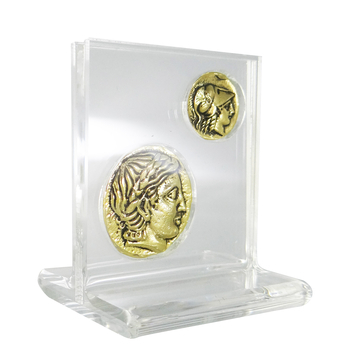
An ancient tomb ful of coins and pieces of gold was found on a municipal property, at Nea Zichni of Serres. The tomb was discovered during digging works of the municipal authorities for the construction of an open air theatre. The mayor of Nea Zichni, mentioned to the Athens News Agency-Macedonian Press Agency, that there are many tombs in the area. The grave goods were delivered at the Ephorate of Antiquities of Serres.
Coins of Alexander the Great from the 3rd and 2nd century BC were found during the excavation of the Amphipolis tomb. Many ancient Macedonian coins have ended up abroad and they are being offered for sale in auctions. Recently, German auction house Gorny & Moschtha announced that it is putting up for auctionancient Greek coinsdating from the Alexander the Great's and Philip's IIera, found at Amphipolis.
The gold stater of Philip II (8,59 g), circa 340-328 BC. It depicts the laureate head of Apollo, facing right. The reverse side of the coin depicts a charioteer, wearing a himation and holding and the reins, driving a two-horse chariot. It also bears the inscription Philippou (Φιλίππου). Macedonian coins are kept at the Numismatic Museum in Athens.
Amphipolis, travelling to myth

In 437 B.C. the Athenians found a colony in the area of Strymonas river, near Serres, under the name of Amphipolis, in order to control and exploit the goldmines of Pagaion mountain nearby, where they mined valuable gold. In 424 B.C, during the Peloponnesian War, the Spartans and their general, Vrasidas, arrived in the area to reinforce their presence in Chalkidiki. Vrasidas managed, in 422 B.C, to occupy the important and wealthy city of Amphipolis. During the Battle of Amphipolis, Vrasidas and six more Spartans were killed, but Athenians, under the commands of general Kleon, lost the battle and 600 soldiers. This battle rendered to the completion of the first part of the Peloponnesian War and the contract of Nikiios Peace Treaty, in 421 B.C.
Amphipolis was later occupied by the Macedonian king Philip the Second and became a centre of high importance in the Macedonian Empire. There, in 311 B.C, Kassandros incarcerated and murdered Roxane and her son Alexander the Forth.
Nowadays, Amphipolis became known due to the revelation of a very important tomb. Kasta Tomb (that's the modern name of the tumulus hill) was first excavated by archaeologist Dimitrios Lazarides in the 50's. He discovered near the surface of the hill a number of graves that date back to the Iron Age, as well as the marble base of the famous statue: "Lion of Amphipolis" . Parts of this huge statue were found by soldiers in 1913 and 1916, while the rest of the lion was discovered in 1937 during constructive works in the area. This statue is considered to be sculpted in the 4th century B.C. and it is believed that its original position was on the top of the newly discovered Amphipolis Tomb.
The excavations in this position of the hill continued in 2012 by archaeologist E. Peristeri and focused on the surrounding wall of the tomb. The excavations extended and brought to light the entrance and the interior of the tomb. The tomb was found to consist of three arched, marble chambers. Above the entrance portal two Sphinxes were discovered, while before the portal of the second chamber stood two exceptional Caryatids. The floor of the second chamber was covered with an astonishing pictorial mosaic that depicts "The abduction of Persephone". The floor of the third chamber, now, was made of stones that covered a vault where a huge, marble coffin was discovered and the skeletal remains of the dead were located. According to the archaeologists, the tomb is dated between 325 and 300 B.C and might be work of Dinocrates, the architect of Artemis Temple in Ephesus and the designer of Alexandria. Whatever this amazing tomb unravels in the near future, the historical importance of the findings is high and will shed some light on the intense years of Alexander the Great.
On the go… for kids!
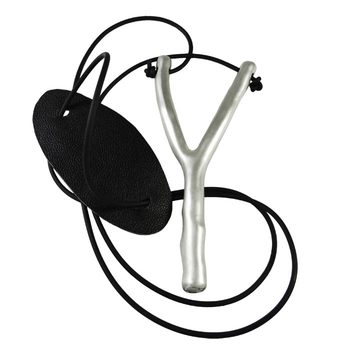
We start the new year, at Museum Masters, feeling fresh and full of ideas for our e-shop and the time has come to accomplish one of our goals on our new year's resolutions list.
We've been working hard, since the start of the year, to bring to you a new category on our e-shop, dedicated to our younger friends, the Kids Corner. Our new category is almost ready and it already includes an exclusive selection of products, such as t-shirts, boxes, toys, figurines, baby rattles and statuettes, inspired by antiquity. We're excited to receive your feedback.
Follow us on Pinterest, Facebook,Twitter, Youtube and Google+ for our latest updates and stay tuned to our blog for all the action, as it happens.
Olympia
The peak of athleticism and sportsmanship could be no other than the verdant Olympia. A harmonious and sunbathed region which could be the one that could inspire such kind of ideals. The Olympic Games were established in an ever green valley surrounded by two rivers, Alfeios and Kladeos. The sacred hill of Saturn was standing inside the sanctuary of Olympia. Saturn, father of Zeus, was already being honored there from the Neolithic era. In the centre of Olympia,there was a radiant for estnamed “Altis”which enclosed the most imperative edifices of the sanctuary, the templesand the athletes' offerings in honor of the gods. There stood the sacred olive tree, the silver leaves of which were adorning the heads of the winners.
The Olympic Games were held every 4 years and the first recorded took place in 776 B.C., whereas the archaeological findings indicate that before 776 B.C the games were already a well-established event. The period of 4 years between the Olympiads was called “penthetiris”. During this interval, local noblemen from Olympia and other nearby cities, named “spondofori”, visited all the greek cities and imposed the “Olympian Truce”. The truce lasted 3 months and during this period of time every war or dispute was suspended so as the athletes could freely participate in the festive event. The first and only sport of the Olympic Games was the “'stadium”; a 192 metre race equal to the length of the Olympic stadium. Gradually, the sports multiplied and “diavlos” (400m race), “dolihos” (4.800m race), “pentathlon”, “wrestling”, “pugilism”, “pankration”, “chariot races” and “horseracing” were added in the sports' programme. The Olympic Games became popular amongst the greek cities and all the greek athletes arrived in Olympia to compete and to win the most glorious competition of the antiquity. The spectators were not less than the athletes. Crowds of people congregated at the sanctuary of Olympia not only to celebrate the youth but also to meet magnates of that time: famous statesmen, orators, generals, artists, who, also, visited Olympia.
The games lasted 5 days. In the first day of the event, the organizing comitee gathered the athletes and the visitors in the altar of Zeus in“Altis” to honour the protector of Olympia, Zeus. They made sacrifices and offered religious artefacts both to the altar and the temple of Zeus nearby. This temple was a real jewel of architecture and the most impressive sample of doric style. It was constructed in 470 B.C. by Libon, a local architect. But the most exciting thing about this temple was the statue inside. The temple housed one of the seven wonders of the ancient world: the ivory and gold statue of Zeus. This 13m high oeuvre of Pheidias had a wooden understructure that was covered with gold and ivory panels. A trough rounded the base of the statue where olive oil was poured in order to reflect the golden pieces of the statue and make it even more impressive. Unfortunately, the fury of the byzantine emperor Theodosius A' destroyed this magnificent artwork as well as the whole sanctuary of Olympia. In 393 A.D. the last Olympic Games are held and shortly afterwards Theodosius A' declared the suspension of the Games as they were considered pagan and idolatrous acts. 1.503 years will be needed until the French baron, Pierre de Coubertin, would revive the ideals and the glory of the Olympic Games and would bring together all the athletes of the world.
As another year goes by…!
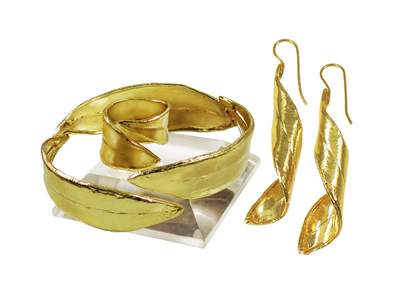
As we head into the new year, we couldn't help, but to look back to this great year and realize how truly grateful and proud we are. We wanted to take a quick moment to say "thank you" for all of your support and the encouragement that you have sent our way this past year.
It has been a huge pleasure running this e-shop in 2014! From the first days of the year until these last moments, it has been a pleasant "journey" for everyone involved here at Museum Masters.
We've had a fantastic year watching our creations and collections "expand" and our fans and friends become more and more. Our popularity "grow" and it is all happened thanks to everyone, who have taken time to follow along and to share their thoughts about our creations, through your purchases and social media (Pinterest, Facebook,Twitter, Youtube). We have appreciated all of your ideas, comments, replies, opinions and we hope that we've done an good job in creating your personalized and corporate gifts.
We look forward to keep up the good work in the New Year and to share with you all our new creations and news.
Best wishes for a happy and prosperous New Year.
A jug full of wishes!
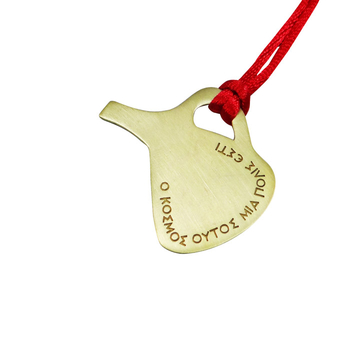
As we head into the new year, Museum Masters, is excited to share with you our "lucky" charm, which according to tradition is offered for good luck. The "Ancient Wine Jug", our charm for the year 2015, aims to "unite" the ancient Greek tradition with our everyday life, and has many elements from Ancient Greece and a toast for peace for the upcoming new year.
This characteristic beak-spouted jug is a fine example of the Prepalatial Minoan civilization and it is combined with the saying of the ancient Greek philosopher Epictetus "The world of ours is a single city", in order to "fill" our hearts with this message of peace, hope and unity for 2015.
Chic, modern but also a traditional gift, the "wine jug" was originally created as a new pendant for our jewelry collection, but its unique message gave a new "twist" to its creation! We placed the number 15 in pure silver or gold plated silver on the back side of the jug, to welcome the new year. It is made of gold-plated bronze and can either be offered as a lucky charm, a pendant or a key-ring. Offer it as a gift to your loved ones to wish them a Happy New Year!
ART OBJECTS: Art an Integral Part of Our Lives
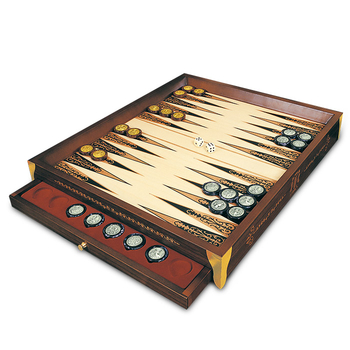
Museum Masters, in cooperation with Palmie Bistro, is pleased to invite you to a unique exhibition of selected works of art entitled “ART OBJECTS: Art an Integral Part of Our Lives”. Items will be displayed at Palmie Bistro restaurant at Kefalari, starting December 4th, 2014, until January 10th, 2015.
The exhibit, under the direction and experience of Mrs Dorit Meir, will include distinctive yet practical objects of art, personally chosen from a wide selection of exclusive designs from selected Museums and Artists. The exhibition features objects, most of which are handcrafted, and will maintain their beauty and value over time.
Bursts of color, gold canvases, precious metals and whitewashed porcelain will inspire you to choose special but affordable gifts this holiday season.
Visit ART OBJECTS exhibition and make your purchases, during these festive days and enjoy 20% discount on the exhibits and furthermore 25-50% discount on gold-plated charms and christmas ornaments.
1st Forum for Sustainable Buildings in Greece
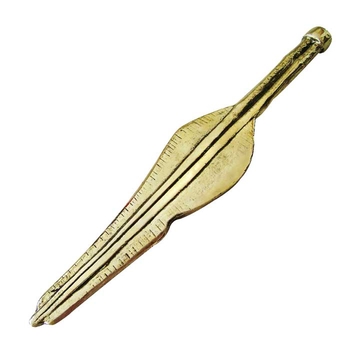
MuseumMasters.gr supports the 1st Forum for the Implementation and the Business Case for Sustainable Buildings in Greece and sponsors the gifts of the event. Our workshops will offer handmade brass letter openers, copies of ancient leaf-shaped spears, which are exhibited at the Museum of Ancient Olympia.
For the last 5 years sustainability is the strongest global trend in the building industry. Due to the prevailing economic crisis in Greece, the country has been left out of the global trend. The entrance of international players in the market is set to change this. In addition, the crisis creates opportunities and acts as a catalyst to redefine principles, targets and practices that can establish sustainability in the built environment.
With this belief, Building Green Magazine, Ecoveritas, Inzeb and Sustain organize the first forum for the implementation and the business case for sustainable buildings in Greece, that will take place in the “Nikos Skalkotas” Hall of Megaron on October 18th 2014.
The major scope of the forum is to present with clarity the characteristics and the context of sustainable buildings, the experience gained from implementation in Greece and the business case.
Through presentations and interactive discussions among industry professionals and sustainability experts, the forum will provide an opportunity to its participants to gain knowledge and enhance their network within the forthcoming era of sustainability in the building industry.
The forum is addressed to all building industry professionals wishing to remain active and up to date with the rapidly changing marketplace of the design, construction, refurbishment, operation and management of sustainable buildings as well as the rapidly changing environment of investments in sustainable real estate assets and real estate funds.
Section 1 – THE CONTEXT AND CHARACTERISTICS OF SUSTAINABLE BUILDINGS
The wider context of sustainable buildings will be presented with clarity (Definition of sustainable building, green washing, transparency, stakeholders, leading sustainability certification systems (BREEAM & LEED), sustainability performance of real estate funds, European market and European and Greek legislation.
Panel: Ecoveritas, Sustain, Inzeb, Greenworks, Habitech, Bopro, John Pike.
Section 2- THE EXPERIENCE GAINED THROUGH IMPLEMENTATION FOR SUSTAINABLE BUILDINGS IN GREECE
Pioneer companies present and discuss their experience for their certified sustainable buildings in Greece. An invaluable and multifaceted presentation of the stakeholders experience assigned to different roles such as construction companies, developers, owners and users of BREEAM & LEED certified sustainable buildings.
Panel: AB Vassilopoulos, Dimand, Cosmote, P.Levantis Ependitiki, Apivita, DCarbon.
Section 3 – THE BUSINESS CASE FOR SUSTAINABLE BUILDINGS IN GREECE
Real Estate Funds, Bank subsidiaries, real estate consultants and valuers present and discuss market awareness, investment risk, supply and demand and the prospects of sustainable buildings in the Greek market.
Panel: NBG Pangaea, Grivalia Properties, Alpha Astika Akinita, Bluehouse Capital, Athens Economics (Jones Lang LaSalle), Colliers, Danos/BNP Paribas Real Estate, RICS.
We run... faster than his shadow
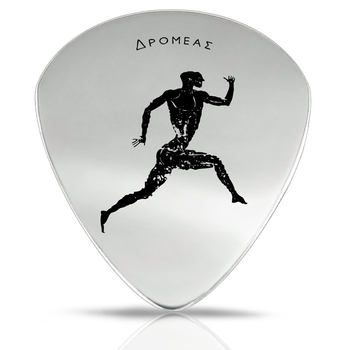
For the 6th consecutive year, the Pan-hellenic Association of Women with Breast Cancer "Alma Zois" organized the Race for the Cure in Greece, which consists of 5k Run Race and 2k Walk.
Spreading the message "We run… faster than his shadow", Mrs Liz Chrysanthidoy-Philippakis and Mrs Dorit Meir-Esdras (MuseumMasters.gr, CoinsClub.gr, Shine4ever.gr), supported with their presence this year's event, which was held on Sunday, September 28th, at Zappeion, at 10:00 a.m.
The Race for the Cure is the biggest global initiative to raise awareness on the prevention of breast cancer. The race takes place for 31 years now in more than 140 cities worldwide by the American organization Susan G. Komen for the Cure.
MuseumMasters.gr sponsors the gifts for the plenary meeting of FIN-NET in Athens!
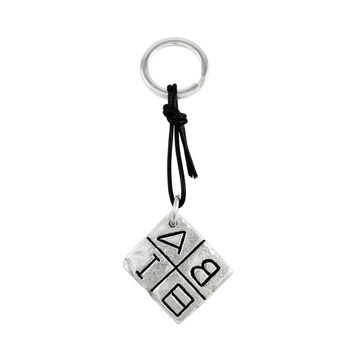
MuseumMasters.gr offered the gifts for the biannual plenary meeting of FIN-NET,which took place in Athens last June, for the first time in the network's history.
The unique handmade gifts, that were offered to the participants were inspired by ancients coins and themes from the ancient and modern history of Greece, promoting thus greek culture and hospitality.
FIN-NET operates under the auspices of the European Commission and it is a financial dispute resolution network of 54 national out-of-court complaint schemes in the European Economic Area countries. FIN-NET Members from Greece are the Hellenic Ombudsman for Banking - Investment Services (H.O.B.I.S.) and the Directorate of Insurance Enterprises and Actuaries of the Ministry of Development. The Ombudsman for Banking - Investment Services was represented by its President and General Secretary of the Union of Greek Banks Mr. Christos Gortsos and the Ombudsman, Mr. Dimitrios Pavlakis.
Latest Articles
-
Nov 10, 2022Philippakis Art workshops participation at the Souvenir Expo Greece 2024!
-
Oct 20, 2022Celebrate with us this coming holidays!
-
Aug 1, 2022Summer Vacations 2022
-
Jan 15, 2021Our work with Artists, Georgios Kastriotis
-
Sep 8, 2020Benaki Museum, A hidden treasure!

